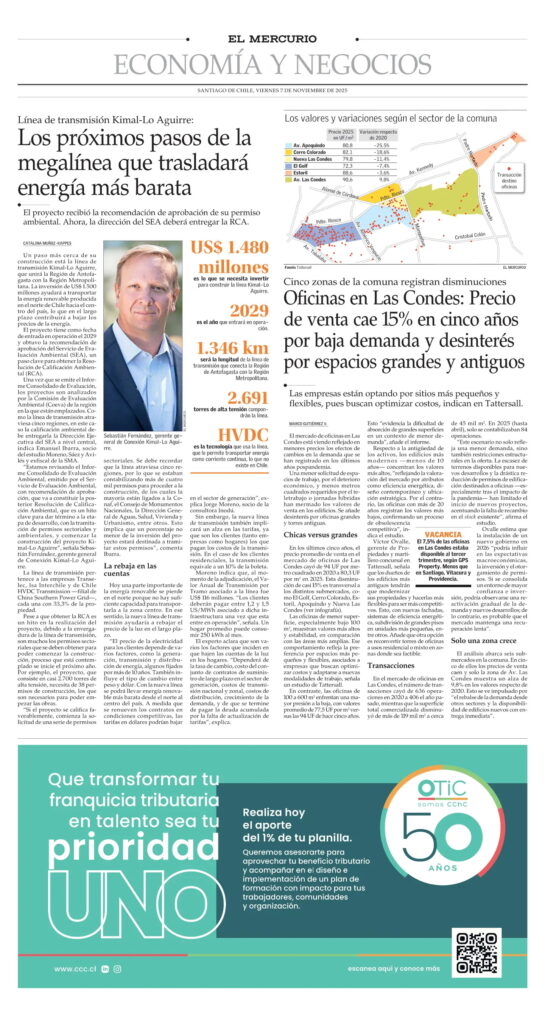The project received a recommendation for approval of its environmental permit. Now, the SEA management must issue the RCA.
The Kimal-Lo Aguirre transmission line, which will connect the Antofagasta Region with the Metropolitan Region, is one step closer to construction. The US$1.5 billion investment will help transport renewable energy produced in northern Chile to the center of the country, which in the long term will contribute to lower energy prices.
The project is scheduled to begin operating in 2029 and has been recommended for approval by the Environmental Assessment Service (SEA), a key step in obtaining the Environmental Qualification Resolution (RCA).
Once the Consolidated Evaluation Report is issued, the projects are analyzed by the Environmental Evaluation Commission (Coeva) of the region in which they are located. As the transmission line crosses five regions, in this case the environmental qualification must be issued by the SEA’s Executive Directorate at the central level, according to Emanuel Ibarra, partner at the Moreno, Sáez y Avilés law firm and former prosecutor at the SMA.
“We are reviewing the Consolidated Environmental Assessment Report issued by the Environmental Assessment Service, with a recommendation for approval, which will constitute the subsequent Environmental Qualification Resolution, a key milestone in completing the development stage, with the processing of sectoral and environmental permits, and begin construction of the Kimal-Lo Aguirre project,” says Sebastián Fernández, general manager of Conexión Kimal-Lo Aguirre.
The transmission line is owned by Transelec, Isa Interchile, and Chile HVDC Transmission—a subsidiary of China Southern Power Grid—each with a 33.3% stake.
Although obtaining the RCA is a milestone in the project’s implementation, due to the size of the transmission line, many sectoral permits must be obtained before construction can begin, a process that is expected to start next year. For example, the project, which consists of almost 2,700 high-voltage towers, requires 38 construction permits, which are necessary to begin work.
‘If the project is approved, the application for a series of sectoral permits will begin. It should be remembered that the line crosses five regions, so more than 4,000 permits were being counted to proceed with construction, most of which are linked to CONAF, the National Monuments Council, the General Water Directorate, Health, Housing, and Urban Planning, among others. This means that a significant percentage of the project’s investment will be allocated to processing these permits,” says Ibarra.
Lowering the bills
Today, a significant portion of renewable energy is lost in the north because there is not enough capacity to transport it to the central region. In this sense, the new transmission line would help lower electricity prices in the long term.
“The price of electricity for customers depends on several factors, such as energy generation, transmission, and distribution, some of which have been fixed for more than 10 years. The exchange rate between the peso and the dollar also has an influence. With the new line, cheaper renewable energy can be brought from the north to the center of the country. As contracts are renewed on competitive terms, dollar rates could fall in the generation sector,” explains Jorge Moreno, a partner at the consulting firm Inodú.
However, the new transmission line will also mean higher rates, as it is customers (both businesses and households) who pay the transmission costs. For residential customers, transmission accounts for 10% of the bill.
Moreno indicates that, at the time of the award, the Annual Transmission Value per Section associated with the line was US$116 million. “Customers will have to pay between 1.2 and 1.5 US/MWh associated with this infrastructure once it becomes operational,” he says. An average household can consume 250 kWh per month.
The expert clarifies that there are several factors that influence the reduction of household electricity bills. “It will depend on the exchange rate, the cost of long-term supply contracts in the generation sector, national and regional transmission costs, distribution costs, demand growth, and the repayment of the debt accumulated due to the failure to update tariffs,” he explains.
